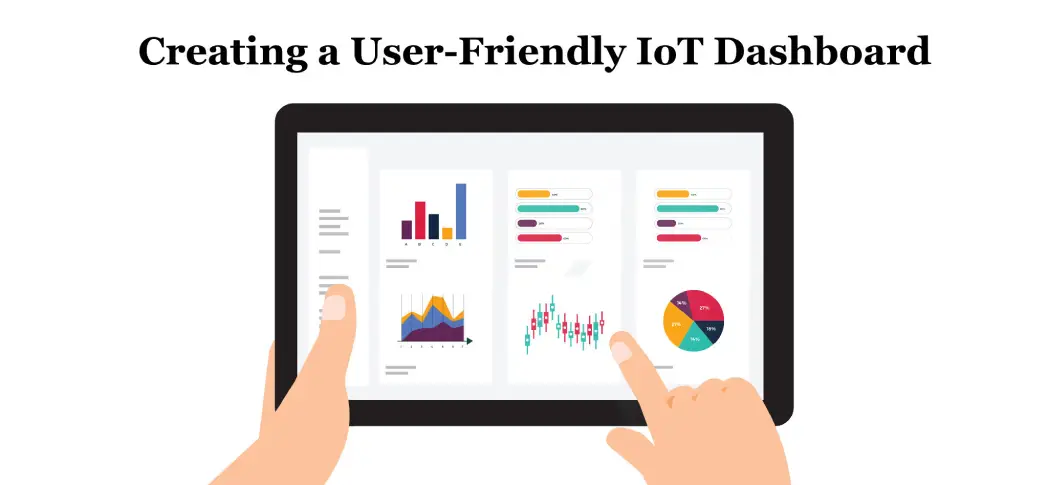Last Updated on September 8, 2023 by Team Experts
An IoT dashboard is a central control panel in the form of an app/website that is used to monitor and control smart devices that are connected to the internet.
The success of IoT devices is always linked to their hardware performance, but it’s the real-time data and data analytics that play a massive role in the success of a smart device.
Gaining insight and comparing data is crucial for making any decision. An IoT dashboard allows you to make insightful decisions about your smart devices and sensors.
Being one of the best IoT companies in Noida, we have expertise in developing a user-friendly dashboard. So, here is a detailed guide on how to create an interactive IoT dashboard.
A Bit About an IoT Dashboard
IoT is all about making devices smart and automated. But you also have to manage and monitor the workings of these devices to ensure they operate properly.
This is where the IoT Dashboard comes in. An IoT dashboard is a digital interface within an IoT platform that lets you monitor and even interact with these smart devices.
The IoT Dashboard allows you to gain perspective of your desired environment through the visualization of your device data in the form of graphs, charts, and other UI elements.
Steps for IoT Dashboard Development
A big part of the IoT component is IoT device control and monitoring, data collection and processing, data management, and data analysis. To get all of this, you need a complex system.
To create a web-based IoT dashboard, you first have to select a network and a protocol and decide whether to go with a custom-made or off-the-shelf dashboard.
1. Choose a Network
An IoT network is built with a three-level architecture: devices, gateways, and data systems.
The data moves between these levels through four types of transmission channels, viz-
- Device to device
- Device to gateway
- Gateway to data
- Between data systems
Now, regardless of what connection type you choose, you will need a network to support it. Based on your goals, you can choose one of the following networks:
- Nanonetwork: It is applied in military and biometrics cases and works with small sensors and microchips.
- NFC (Near-field communication): It is used to connect devices that are near each other (within 4cm). Contactless payment is one good example.
- PAN (Personal Area Network): This network connects devices within a radius of one or two rooms.
- BAN (Body Area Network): It connects wearable devices that are fixed to the body or embedded inside the body.
- LAN (Local Area Network): This network covers the area of one building
- CAN (Corporate Area Network): It serves to link devices within an organization.
- MAN (Metropolitan Area Network): A big network built to create smart cities or specific areas of a city.
- WAN (Wide Area Network): A network that exists over a large geographical area and unites LAN and MAN.
Choose IoT Protocols
Protocols are needed to connect devices to apps and to each other. Some of the important protocols that work with IoT dashboards are:
- MQTT (Message Queuing Telemetry Transport): It is best suited for small and less powerful devices. It sends data through three components: subscribers, publishers, and brokers.
- DDS (Data Distribution Services): It is built for computing and supporting more complex systems.
- AMQP (Advanced Message Queuing Protocol): It is an application layer protocol for message-oriented middleware environments.
- Bluetooth: It is a short-range communication technology. You all must be familiar with it as it’s integrated into smartphones and mobile devices.
Select Custom-made or Off-the-shelf IoT Dashboard
Custom-made IoT Dashboard
Developing a custom IoT Dashboard from scratch is indeed a complex task, as it requires a diverse range of resources and expertise. However, it also allows you to develop something that perfectly fits your goals. With a custom-made IoT dashboard, you can personalize the dashboard by adding features that fulfill your requirements.
The IoT dashboard development process will require a good amount of money and a skilled workforce. But this is a short-term thing. In the long term, it will help you save a hefty sum of money by making your operations more effective and efficient.
Here’s a quick rundown of the pros and cons of choosing a custom-made IoT dashboard.
| PROS | CONS |
| Custom features Zero Involvement of third parties Data Security More flexibility | Requires a skilled development team Large investment |
Off-the-shelf IoT Dashboard
If you do not want to build the dashboard from scratch, purchasing an IoT dashboard is always a solution. They are significantly cheaper and ready to implement. However, you have to depend on the third-party vendor and their policies.
However, with an off-the-shelf solution, you won’t get a customization option.
In addition, there is no one payment, you have to pay every month, and if you want to add an extra feature, you will have to pay for it as well.
| PROS | CONS |
| Immediate access In-built features | It’s hard to add or remove features Monthly payments Low customizability |
To Conclude
Internet of Things technology is used to make our day-to-day lives easier. With the help of an IoT dashboard, you can make your life more productive and insightful.
However, IoT dashboard development is a complex task. You have to structure your solution and select a device based on the environment and your requirements.
A well-designed user-friendly dashboard allows you to view data sets that you can select, creating a nonfussy, easy-to-understand, and real-time snapshot of in-field devices and system-level performance.
There are two main ways to develop an IoT dashboard- developing your own solution or trusting ready-made solutions.
If time is not an issue for you, then opting for custom-made IoT dashboard development is the best solution.
Hope this helps!

